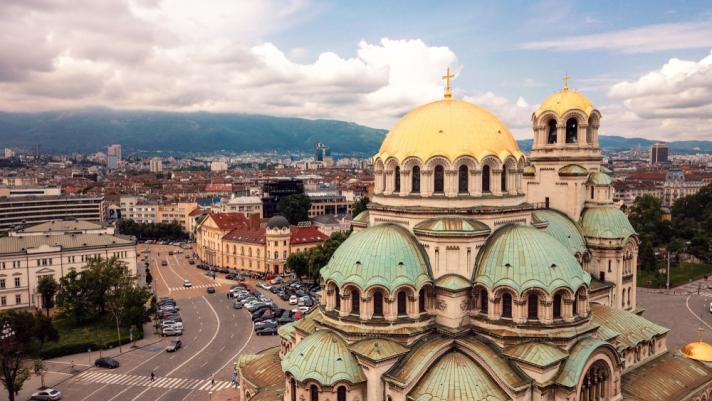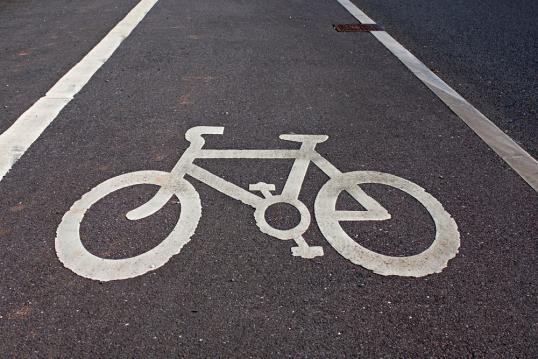- Topic
- Urban mobility planning
- Country
- Bulgaria
- Resource type
- Case study
First published on 16 June 2023.
Sofia is the fastest growing city in Bulgaria. The continuous growth and development of the city, however, puts pressure on its transport infrastructure, as well as undermines its liveability and attractiveness as one of the best places to live and work in the country. Faced with high congestion and significant air pollution, Sofia is taking action to transform its mobility system to make it more sustainable. It is not an easy challenge, as many in the city still consider the car as a necessity and/or a status symbol. With an integrated approach, the sharing of information and cooperation, Sofia is trying to progressively develop sustainable mobility solutions and behaviour.
Context
Sofia, the capital of Bulgaria, is the largest urban area and economic centre in the country. Around 43% of the country’s GDP is produced in the city. Officially, the city has just below 1.3 million inhabitants. However, it is estimated that the real figure is between 1.6 and 1.8 million people, as many people living in Sofia are registered elsewhere. In addition, the city attracts a substantial number of daily commuters from nearby cities. Many commuters travel by car to the city centre, where much of the economic activity is concentrated.
Growing traffic flows have resulted in congestion and traffic jams becoming an everyday occurrence in the city. The share of passenger car use in the modal split is currently 35%[1]. Car ownership has been increasing over the past three decades. With 663 cars per 1,000 inhabitants (2020), the number of private vehicles registered per capita in Sofia is one of the highest in Europe. The vehicles in use are also old and polluting. One quarter of all vehicles are over 20 years old and 60% are between 10 and 20 years old. Road traffic contributes to air pollution, which is a very significant problem in Sofia. According to two recent studies[2], health and other economic costs of air pollution are equivalent to more than ten percent of the city’s GDP.
To address these challenges, the city has adopted an integrated approach to improve accessibility, reduce congestion and improve air quality and living conditions. In 2019, the City Council adopted its Sustainable Urban Mobility Plan (SUMP), which is the foundation of all measures and projects that aim to transform mobility in Sofia. It focuses on building an integrated transport system by promoting the use of sustainable transport modes, greening the city’s transport system and promoting its digitalisation.
In action
The city’s SUMP strives to achieve five main objectives by 2035:
- To reduce the negative consequences of transport development for the population and the environment;
- To enhance the attractiveness of the urban environment and increase the living standards of the population;
- To implement transport innovations to strengthen local mobility and economic development;
- To foster the safety of participants in the city’s transport system;
- To build an integrated and accessible-to-all transport network.
To achieve the objectives of its SUMP, several initiatives were launched to progressively change mobility patterns in the city.
The preparation of the SUMP already constituted a change from the preparation of previous plans, in terms of its integrated approach, data collection and cooperation. Sofia applied a new methodology for collecting mobility-related data and created a database to support the development of medium and long-term (mobility) strategies in the city. The development of the database was based on a systematic data collection approach, in which data from different policy domains were collected. While the database is hosted by Sofiaplan, the municipal enterprise responsible for spatial and strategic planning of the Metropolitan Municipality, planners and policy makers from various policy domains contributed to its development (and continue to do so). Its development involved the interaction and exchange of information on data availability and needs between the different planning teams. It enabled, and still enables, interaction between the relevant planning and operational bodies within the municipality, including professionals in the fields of mobility, urban planning, environmental protection and architecture. Regular inter-team meetings draw conclusions on ongoing work and advise on further research needs.
Residents can also contribute to the development of the SUMP. An interactive platform was created through which people could submit their suggestions for projects or activities. Using the interactive map, people can mark where in the city they would like their initiative to be realised. The platform was also used to inform people about the plan and its progress, and to give people the opportunity to provide feedback on the planned actions.
The SUMP covers the period 2019-2035 and includes a range of measures to promote sustainable mobility. The plan recognises that, in order to persuade people to leave their cars and opt for more sustainable means of travel, viable and attractive alternatives need to be in place. It also recognises the need to invest in improving conditions for both walking and cycling. Until the development of the SUMP, the existing walking and cycling networks had longstanding problems of underinvestment, leaving them underdeveloped, poorly maintained and unattractive to users.
In 2019, the total length of the bicycle network was 55.5 km and it lacked uninterrupted safe routes through the city, which resulted in cycling having a less than 2% share of the total number of trips in Sofia. To improve conditions for cycling, the municipality aimed to increase the length of the cycling network by up to 160 km by 2025; five major cycle lanes are currently under construction. Furthermore, with the support of the municipality, the first electric bicycle rental service has been set up and is already functioning, which offers another possibility for residents and visitors to use eco-friendly transport within the confines of the city. One of the flagship projects of the SUMP is the construction of the 'Green Ring’ project, which will establish a 30 km-long park and cycling path around the city centre. Once completed, this will be accessible by some 250,000 people, reaching at least 30 neighbourhoods and districts, and will help transform mobility in the city.
Sofia has also adopted a special programme for the construction and renovation of pavements throughout the city. The programme aims to improve nearly 10% of the total area dedicated to pedestrians in the capital. The total cost of the project is €60 million, of which €50 million will be financed by a loan from the European Investment Bank. Priority will be given to the busiest pavements near schools, hospitals, markets, administrative buildings and cultural institutions. The programme aims to build on previous repairs, which covered 60,000 square metres but targeted only the central areas that were in urgent need of repair.
To further improve conditions for walking and cycling, stricter parking enforcement will be put in place to prevent illegal parking on pavements and cycle paths. Parking management has been included in the SUMP as a mechanism to help manage mobility as well as public space. Parking policy in Sofia’s new SUMP is based on the idea that parking in the city is not a right, but a service that uses public resources and therefore should not be completely free. In December 2021, Sofia significantly extended its controlled parking zones, consisting of a blue and a green zone with different parking time restrictions and fees for parking. The revenues collected will be used to fund pavement renewal and public transport investments.
Responsibility for parking policies and management has been placed with the Sofia Urban Mobility Centre, which is also responsible for the planning and management of public transport operations. The integration of responsibilities for the two areas within one organisation facilitates better coordination of planning, including the development of intermodal hubs, buffer parking spaces and park and ride areas, within key areas of the city.
Improving public transport is a key requirement to increase its modal share. Given the massive investments required to improve both infrastructure and rolling stock for buses, trams and the metro, improvements can only happen progressively over time. Amongst other recent investments, the metro network has been extended significantly over the past decade. Its latest extension opened in 2020 and the current network now has four lines with a total length of 52 km with 47 stations; a further extension is being developed and planned with co-financing of the EU.
In addition to the development of the metro, Sofia is taking ambitious steps to build a zero-emission fleet to expand public transport options and develop an integrated ticketing system for its public transport system. Special tickets have been introduced, giving access to public transport at reduced or at no charge on days when air pollution (i.e. levels of particulate matter) are high or extremely high. Furthermore, Sofia is pioneering on-demand green public transport. This new service will better connect the city centre with three peri-urban areas, where connectivity had been lacking. The service will collect people close to their homes in less than five minutes and take them to the closest bus or train station. Users can book and pay for their journey online. Five pilot electric on-demand buses, each with a 20-person capacity, will begin a one-year trial in 2023. Under the trial, residents of Sofia will be able to use their annual public transport pass (at no extra cost) or buy a single journey for less than €1.
Sofia has also developed a ‘Sofia Coin mobile app’ to encourage people to switch from cars to active transport modes, such as walking, cycling, or using a scooter. The app measures the distance travelled using active modes and the emissions saved per trip, as well as offering rewards, such as free tickets for public transport, electric scooters or public cycle services, thereby encouraging new behaviour. The app also feeds demand data into mainstream mobility infrastructure planning. Both the on-demand public transport and the Sofia Coin mobile app have been developed as part of the INNOAIR project, supported by the Urban Innovative Actions initiative of the EU.
To further curb increasing car ownership and move towards (multimodal) sustainable mobility, Sofia is looking to promote the development and use of shared-mobility services. Shared car-, (e)bike- and e-scooter operations are already active in Sofia, and the city is continuously working to improve the implementation of shared mobility systems and services, while safeguarding public interest. Among others, Sofia has been active in European projects, such as SUSMO, which was funded by the EIT Climate-KIC, and aimed to develop roadmaps for the further deployment of shared mobility, to improve the policy framework in support of such deployment, and to foster public-private sector cooperation.
The implementation of the SUMP is supported by broader city actions in data management and digitalisation. Mobility management is one of the target areas of the Digital Transformation Strategy for Sofia (DTSS). The DTSS, which was finalised in May 2020, resulted from Sofia's participation in the Digital Cities Challenge, an initiative of the European Commission. Actions include the development of a platform to enable the integration of all software solutions, data, service providers, and communities active in the sector of urban transport (public operators, taxis, sharing and pooling of any transport mode); the development of platforms for car-pooling and car-sharing that have a public and non-profit character; and research into the application of flexible pricing models, based on data, to encourage the use of public transport. In addition, the DTSS supports the development of a transport model powered by real-time data that can be used for transport network planning.
Results
Sofia’s SUMP was adopted in 2019. It is too early to tell for sure whether its adoption is making an impact on mobility in the city. However, the approach adopted for the development and implementation of the SUMP has already improved cooperation among stakeholders and the integration of planning in the city. Sofia’s new approach towards data collection and management, not only accelerates the analysis and avoids a duplication of work among different planning teams, it also improves cooperation and widens planning perspectives beyond the “traditional sector silos”[3]. Work on the SUMP and its implementing actions also spurred interaction with the private sector and the public more generally.
No doubt more can and should be done to achieve more sustainable mobility in the city, however important progress is being made. Other actions on sustainable mobility may also help with the implementation of another important action – the introduction of a Low Emission Zone (LEZ) in Sofia. While attempts to install an LEZ have failed in the past, a decision to create an LEZ was made in 2023. The development of the actions in the SUMP have raised (and responded to) the awareness amongst the public and other stakeholders of the importance of taking action to reduce traffic and the air pollution it causes. At the same time, a start has been made in developing high-quality transport alternatives, i.e. reliable public transport, a bicycle network and accessible pedestrian zones. By providing drivers with high quality sustainable mobility options they are stimulated to become less dependent on their cars. With the SUMP, Sofia has created a vision of alternatives and with each implementing action, the alternatives become better and people have more options to plan and experience sustainable journeys.
Challenges, opportunities and transferability
While each city is unique and no approach can necessarily be successfully copied and pasted to another city, the case of Sofia has interesting lessons that could be of value to other cities. Its approach towards data collection and exchange has not only provided useful information for planning and decision making, it also structured and improved cooperation between stakeholders from different policy areas as well as with private sector parties. Collaboration with the latter can open the way for the development of new mobility innovations, which should be assessed based on the merits of their outcomes set against public policy targets.
Digital applications for mobility services can also be important to achieve behavioural change. New applications have attracted a lot of media attention and helped raise awareness about mobility solutions. Still, without the basic infrastructure to support mobility and policies to deter extensive car use, it is unlikely that a large shift in the modes used for mobility will occur. The SUMP does, however, provide the strategic direction for an integrated approach. Starting with its development, each progressive step contained within the SUMP, takes the city further in the development and implementation of actions towards more sustainable mobility.
In Depth
For more details, please contact Mr. Doncho Barbalov, Deputy Mayor “Transport and transport communications”: Tel: +359 (2) 9377 240
[2] CE Deft (2020), Deloitte (2021)
[3] SUMPS-UP, SUMP Good Practice Fact Sheets
Additional sources:
- impacts-of-lez-in-sofia-true-report-en.pdf (trueinitiative.org)
- SUMP-21-05-2019.pdf (sofiaplan.bg)
- Sofia’s Challenges and Solutions in Urban Mobility, Air Pollution and Urban Green Areas (iurc.eu)
- final-health-costs-of-air-pollution-in-european-cities-and-the-linkage-with-transport-c.pdf (cleanair4health.eu)
- Deloitte-CAF-report_v7_compressed.pdf IMPACT OF AIR POLLUTION ON CAREER DECISIONS OF THE HIGHLY-SKILLED WORKFORCE IN SOFIA (pcdn.co)
- Начало — Софияплан (sofiaplan.bg)
- Sofia plans to implement a park and bike lane around the city centre | Eltis
- Sofia is launching an extensive sidewalk renewal programme | Eltis
- Bulgaria: EIB signs an additional loan for €50 million with Sofia Municipality
- Parking Management in Sofia | Eltis
- Parking - Sofia Municipality - Портал на Столичната Община - Портал на Столичната Община
- Urban Mobility Centre - Structure (sofiatraffic.bg)
- Line 3 of Sofia Metro - Metropolitan Sofia
- Home (innoair-sofia.eu)
- UIA - Urban Innovative Actions (uia-initiative.eu)
- EIT Climate | European Institute of Innovation & Technology (EIT) (europa.eu)
- Digital-Transformation-Strategy-for-Sofia-Final-accepted-ENG.pdf (innovativesofia.bg)
- The city of Sofia is to introduce a Low Emissions Zone | Eltis
- sumps-up_-_city_good_practice_factsheets.pdf (eltis.org)
Author: Michael Modijefsky
Views and opinions expressed are those of the author(s) and do not reflect those of the European Commission.
Photo Credits: © Dave Primov, Mihail Minkov, Anton Chalakov, Martin Ludlam - no permission to re-use image(s) without separate licence from Shutterstock.




